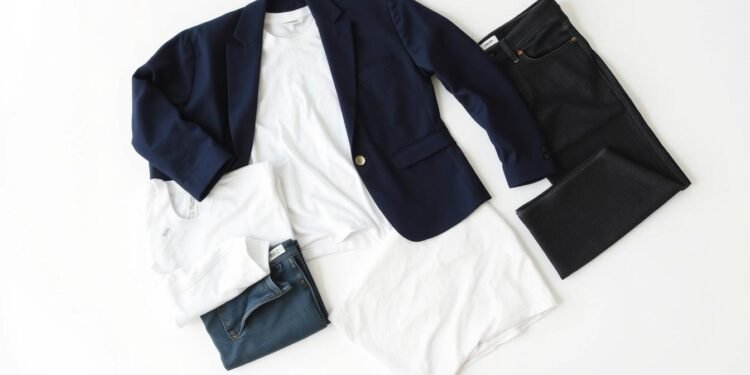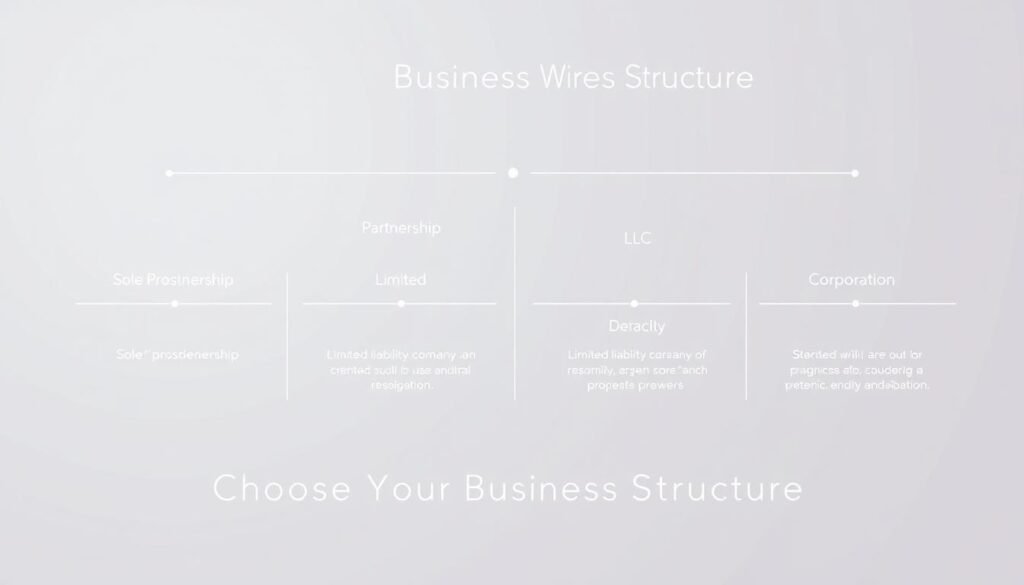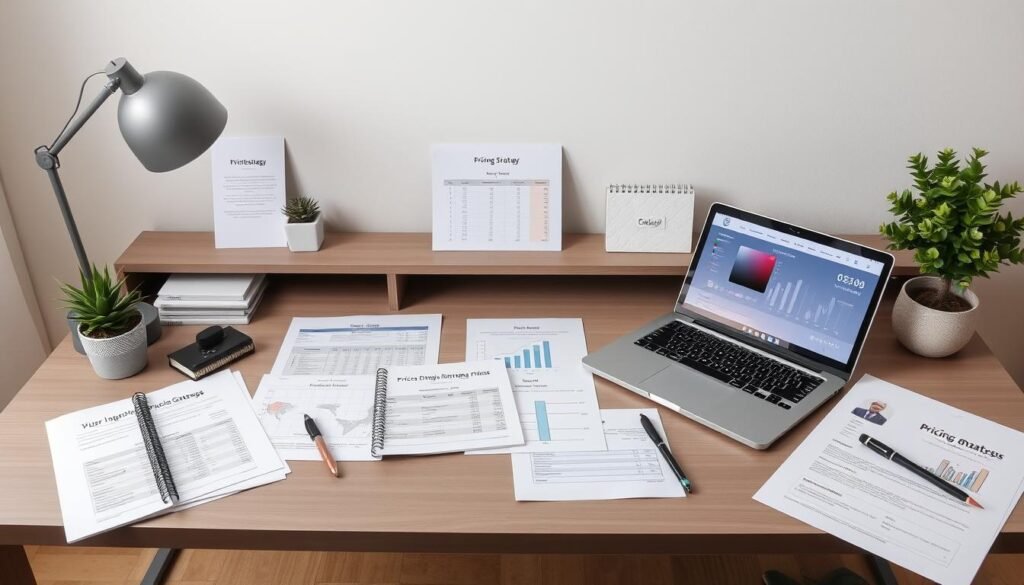Ever wondered why some fashion labels skyrocket while others fade fast? The secret lies in blending creative passion with smart business moves. Launching a successful clothing line takes more than just great designs—it demands strategy, planning, and execution.
Thousands of new brands emerge yearly, but many collapse within months. Award-winning designer Sarah Donofrio, known from Project Runway, emphasizes the need for a clear roadmap. From market research to Shopify store setups, every step matters.
Key Takeaways
- Successful fashion brands merge creativity with business strategy
- Most new clothing lines fail within their first year
- A 15-step process guides entrepreneurs from concept to launch
- Ecommerce platforms like Shopify simplify online sales
- Industry experts provide proven frameworks for success
Introduction
The $1.7 trillion fashion industry offers endless possibilities—but breaking in demands more than just creativity. While global apparel markets thrive, new brands often struggle with poor positioning or rushed launches. Strategic planning separates fleeting trends from lasting success.
Take Vaute Couture, which hit $2M in first-year revenue by targeting eco-conscious consumers. Their story underscores the power of niche markets in a crowded space. Whether you’re designing sustainable activewear or luxury streetwear, understanding your audience is non-negotiable.
Great products need equally strong business foundations. From branding to supply chains, each decision impacts scalability. The next sections will unpack these essentials, helping you turn sketches into a profitable clothing line.
1. Develop Your Fashion Design Skills
Fashion legends like Vivienne Westwood proved self-taught skills can reshape industries. Whether you’re sketching streetwear or tailoring suits, mastering core techniques separates hobbyists from professionals. Industry veteran Sarah Donofrio emphasizes: “Design is the language your products speak before words.”
Learn Basic Design Techniques
Pattern-making, draping, and textile selection form the foundation. Detroit Denim’s training program shows how hands-on practice accelerates skill-building. Start with simple projects—like tote bags or basic tees—to grasp construction principles.
Take Online or In-Person Courses
Platforms like MasterClass (featuring Diane von Furstenberg) or Maker’s Row Academy offer structured learning. Local community colleges often provide affordable fashion design courses with industry-standard tools.
Practice Sketching and Prototyping
CLO 3D software speeds up digital prototyping, while traditional sketching hones creativity. Allocate 70% of your time to design and 30% to business tasks—this balance ensures products resonate with audiences.
2. Identify Your Niche and Target Market
Alba Paris’ $2M vegan leather line proves niches drive profitability. Pinpointing a specific segment ensures your designs resonate deeply rather than blending into saturated markets. Data-driven decisions replace guesswork, turning insights into revenue.
Research Market Trends
Track emerging trends via WGSN or Fashion Snoops reports. Google Trends reveals seasonal spikes in searches like “sustainable activewear,” signaling demand. Ugmonk’s minimalist aesthetic captured a $5M niche by aligning with timeless preferences.
Define Your Ideal Customer
Meta Ads Audience Insights uncovers demographics—age, income, and values. For example, eco-conscious millennials might prioritize ethical production over price. Create a buyer persona template to guide design and messaging.
Analyze Competitors
Use SEMrush to study rivals’ top-performing products and keywords. A SWOT matrix (Strengths, Weaknesses, Opportunities, Threats) for three competitors reveals gaps. Local brand Detox Market thrived by offering organic alternatives where big brands fell short.
3. Create a Clothing Business Plan
Turning creative vision into profit requires more than just designs—it demands a structured financial strategy. A detailed plan prevents costly missteps and aligns production, marketing, and sales. Consider Kotn’s trajectory: their $25K Kickstarter launch scaled to $15M by mapping every dollar.
Outline Your Business Model
Choose between print-on-demand (POD), wholesale, or hybrid models based on upfront costs and scalability. POD minimizes inventory risk, while wholesale demands higher initial money investments. Brands like Printful excel with low-risk POD, whereas Everlane’s hybrid approach balances margins and control.
Set Financial Goals
Project 3-year profit/loss statements using templates from SCORE or Shopify. Allocate 30% of budgets to marketing—a benchmark from brands like Gymshark. Track metrics like customer acquisition cost (CAC) and lifetime value (LTV) to gauge sustainability.
Plan for Scaling
From 100-unit test runs to 10,000-unit orders, phase growth with clear milestones. Partner with manufacturers offering tiered pricing, like Los Angeles Apparel’s volume discounts. Legal prep matters too: LLC formation costs vary by state ($40–$500), impacting long-term flexibility.
4. Choose Your Business Structure
The right business structure protects your assets while fueling growth. Legal frameworks determine liability, taxes, and fundraising potential. Sustainable brand Patagonia adopted a benefit corporation model, blending profit with environmental accountability.
Sole Proprietorship vs. LLC
A sole proprietorship costs just $50 to establish but offers no personal asset protection. LLC formation averages $500 across states, shielding your home and savings from retail liabilities. Fashion brands facing product lawsuits often choose LLCs—like Los Angeles-based Reformation.
Register Your Business
State requirements vary: California mandates $800 annual LLC fees, while Texas charges $300. File with the Secretary of State and obtain an EIN from the IRS. Trademark registration through the USPTO costs $250-$350 per class, securing your brand identity nationally.
Understand Tax Obligations
Sales tax permits are mandatory for businesses selling physical goods. Quarterly estimated taxes apply to sole props, while LLCs can choose pass-through taxation. B Corp certification—a 200-point assessment—grants tax benefits for sustainable operations, as seen with Allbirds.
General liability insurance ($500/year) covers accidents, while product liability ($1,200+) protects against design flaws. Consult a fashion industry attorney to navigate these decisions efficiently.
5. Build a Strong Brand Identity
Distinctive branding turns first-time buyers into lifelong advocates, as Johnny Cupcakes’ 300% growth proves. Your brand identity—name, visuals, and voice—shapes how customers perceive your label. Nail these elements, and you’ll stand out in crowded markets.
Choose a Memorable Brand Name
Tools like Namelix AI generate creative name ideas based on your niche. Always check the USPTO database to avoid trademark conflicts. Outdoor brand Patagonia’s name reflects its rugged ethos, while Glossier’s playful tone matches its audience.
Design a Logo and Visual Assets
Pantone colors and typography pairings create consistency across packaging and websites. Supreme’s bold red box logo became iconic through repetition. Include a visual identity checklist: hex codes, font families, and logo spacing rules.
Define Your Brand Voice
Your style of communication should mirror customer values. Compare Glossier’s friendly tone (“Hey you!”) to Supreme’s rebellious slang. A voice chart ensures team-wide consistency in emails, ads, and social posts.
Packaging also reinforces identity. Unboxing experiences—like textured tissue paper or handwritten notes—boost retention. Trademark filings have a 68% success rate in fashion, protecting your unique brand identity long-term.
6. Design Your Clothing Line
Great designs become iconic when technical precision meets creative vision—ask any fashion entrepreneur. Award-winning designer Sarah Donofrio’s sketchbook-to-production method reveals how structured workflows turn ideas into products customers love. This phase blends artistry with logistics, ensuring every stitch aligns with your brand’s standards.
Sketch Your Designs
Start with rough drafts to explore silhouettes and details. Fashion icons like Rei Kawakubo refine dozens of sketches before selecting final concepts. Digital tools like Adobe Illustrator streamline revisions, while hand-drawn iterations preserve organic creativity.
Select Fabrics and Materials
Material choices impact cost, comfort, and sustainability. Organic cotton often has a 500-yard minimum order quantity (MOQ), while polyester blends may require 1,000+ yards. Reformation’s 65% recycled collection proves eco-friendly alternatives like Tencel outperform conventional rayon in durability.
Create Tech Packs
Tech packs are the blueprint for production. Include CAD drawings, stitch types, and grade rules for sizing. A detailed pack cuts sampling costs—prototypes typically run $150–$500 each. As Donofrio advises: “Ambiguity in specs leads to costly factory errors.”
Mastering these steps ensures your line meets both aesthetic and functional demands. Next, sourcing the right partners will bring these designs to life.
7. Source Materials and Manufacturers
American Apparel revolutionized apparel manufacturing by controlling every step—proof that sourcing strategy defines success. Your choice of suppliers impacts quality, ethics, and profit margins. Smart partnerships turn raw materials into products that resonate with your audience.
Local vs. Overseas Manufacturing
Domestic production offers faster turnaround and quality control but averages $15 per shirt. Overseas options in countries like Bangladesh may cost $3 per unit but require larger minimum orders. Weigh these costs against your brand values and customer expectations.
Negotiate with Suppliers
Seasoned designers secure 15-30% discounts by committing to annual volumes or flexible payment terms. Platforms like Texpedi connect brands with vetted fabric suppliers, while Queen of Raw repurposes deadstock materials. Everlane’s transparent pricing model shows how open communication builds supplier trust.
Ensure Ethical Production
Certifications like Fair Trade or WRAP audits verify safe working conditions. Over 60% of consumers now prioritize ethical sourcing when choosing apparel brands. Build this into your supply chain from day one to align with market expectations.
Vertical integration—owning production facilities like American Apparel did—reduces lead times but requires major capital. Most startups benefit from hybrid models: local sampling with overseas bulk orders. Always visit factories personally before signing contracts.
8. Set Up Production and Quality Control
Zara’s lightning-fast 5-week production cycle shattered industry norms, proving speed and quality can coexist. While traditional timelines stretched six months, smart brands now merge efficiency with excellence. Your products deserve this same disciplined approach—where every stitch meets exacting standards.
Prototype and Sample Testing
Quality begins with prototypes. Measure stitch-per-inch (SPI) ratios against industry benchmarks—8-12 SPI for knits, 12-16 for wovens. Digital tools like Techpacker automate spec sheets, reducing sampling time by 40%.
Implement Quality Checks
Nike’s 99.9% acceptance rate stems from triple-stage inspections. Adopt their ABC method: Assess materials, Build checkpoints, Confirm tolerances. Color fastness tests and seam strength evaluations prevent defective products from reaching customers.
Manage Production Timelines
Offshore manufacturing typically requires 8-12 weeks lead time. Systems like AIMS360 sync with factories to track delays. Smart brands buffer 2 extra weeks—this prevents inventory waste when defects occur. Remember: Rushed timelines often mean compromised quality.
9. Price Your Products Strategically
Pricing separates thriving fashion labels from those struggling to stay afloat. A well-crafted strategy balances profitability with perceived value, turning inventory into sustainable money streams. Brands like Lululemon command premium prices by aligning numbers with customer expectations.
Calculate Costs and Margins
Start with the formula: COGS + overhead + profit margin. Industry standards suggest a 2.2–2.5x wholesale markup. For example, a $10 production costs per unit should retail for $22–$25.
Factor in hidden expenses like shipping or returns. Use tools like QuickBooks to track margins in real time. Small adjustments here compound into significant profit gains.
Competitive Pricing Analysis
Study rivals on platforms like Shopify or Amazon. Note their price floors and bestsellers. Supreme’s 1000% markup works because exclusivity justifies it—but most brands thrive in narrower bands.
Set a Minimum Advertised Price (MAP) policy to prevent discount wars. Templates from the FTC ensure compliance while protecting your retail positioning.
Offer Value-Based Pricing
Charge what customers will pay, not just what your costs demand. Psychological pricing ($49.99 vs. $50) boosts conversions by 15%. Bundle products or offer limited editions to heighten perceived worth.
Lululemon’s $98 leggings succeed because quality and branding justify the price. Test different tiers—sometimes a higher tag increases desirability.
10. Plan Your Inventory Management
H&M’s $4.3B deadstock disaster shows why smart inventory control makes or breaks fashion brands. The right balance prevents cash flow nightmares while keeping your store stocked with bestsellers. Modern solutions blend data analytics with flexible production models.
Forecast Demand Accurately
Tools like StyleSage analyze social media trends to predict which products will sell. Omnilytics tracks real-time sales data across 800+ retailers. These platforms help avoid overordering—a common pitfall that created H&M’s massive write-off.
Combine historical sales with market indicators. A 3-month test run with small batches often reveals true demand before full production.
Implement Smart Inventory Systems
RFID tagging provides real-time stock visibility but costs $0.15-$0.75 per tag. For emerging brands, cloud-based software like TradeGecko offers affordable tracking. Just-in-time (JIT) systems work well for made-to-order items, reducing storage costs by 40%.
Safety stock calculations should account for lead times and demand variability. The formula: (Maximum Daily Usage × Maximum Lead Time) – (Average Daily Usage × Average Lead Time).
Eliminate Deadstock Strategically
Zara’s 85% sell-through rate comes from producing limited quantities and rapid restocking. Their model proves small batches outperform bulk ordering. Pre-order campaigns let customers reserve items before production—eliminating guesswork.
For existing deadstock, consider flash sales or donations for tax deductions. Some brands repurpose materials into new collections, like Eileen Fisher’s Renew program.
11. How to Start a Clothing Brand Online
Gymshark’s $1.4B valuation proves ecommerce platforms are the new runway for fashion brands. With 73% of apparel sales happening via smartphones, your online store must blend aesthetics with functionality. Platforms like Shopify simplify this transition, hosting 1.75M+ businesses globally.
Choose an Ecommerce Platform
Shopify’s drag-and-drop builder suits beginners, while WooCommerce offers WordPress integration. BigCommerce scales better for high-volume sales. Compare transaction fees (Shopify: 2.9% + 30¢) and customization options before committing.
Set Up Your Online Store
Essential steps include domain registration, SSL certification, and payment gateway setup. Apps like Oberlo streamline dropshipping, and Klaviyo automates email campaigns. Test checkout flows rigorously—53% of carts are abandoned due to complex processes.
Optimize for Mobile
Google prioritizes mobile-friendly sites in rankings. Use accelerated mobile pages (AMP) and compress images to under 100KB. Font sizes below 16px hurt readability. Case in point: Revolve’s mobile revenue jumped 30% after redesigning thumb-friendly menus.
12. Market Your Clothing Brand
Fashion Nova’s $5M monthly influencer spend reveals the power of modern brand promotion. Today’s winning strategies blend viral content with precision targeting, turning followers into customers. These tactics outperform traditional marketing, as Princess Polly’s 300% ad return demonstrates.
Leverage Social Media Platforms
TikTok Shop drives 3x more conversions than static posts, while Instagram Reels boosts discovery. User-generated content (UGC) campaigns yield 92% higher conversion rates—encourage customers to tag your products.
Prioritize platforms where your audience spends time. Gen Z favors TikTok’s trending sounds, while millennials engage more with Instagram carousels.
Run Data-Driven Ad Campaigns
Meta’s retargeting tools recover 26% of abandoned carts by showing previous visitors their viewed items. Start with a 70/30 budget split: 70% for proven performers, 30% testing new creatives.
Dynamic product ads automatically showcase items based on browsing history. This tactic lifted Princess Polly’s revenue by 300% within six months.
Collaborate with Strategic Influencers
Nano-influencers (1K-10K followers) deliver 8.7% engagement rates—triple that of celebrities. Offer tiered partnerships: free products for micro-influencers, paid rates ($100-$5K) for macro-influencers.
Create clear rate cards outlining deliverables like story posts or try-on hauls. Always track promo codes and UTM links to measure ROI per collaborator.
13. Sell Through Multiple Channels
Modern shoppers expect to discover and purchase your products wherever they browse, from boutiques to digital marketplaces. Allbirds’ 50+ physical locations supporting their direct-to-consumer model demonstrate the power of omnichannel distribution. Diversifying your sales approach reduces risk while maximizing visibility.
Wholesale Versus Direct-to-Consumer Models
Wholesale partnerships with department stores offer instant scale but typically yield 50-60% margins after distributor cuts. Direct sales through your website retain 70-80% margins but require heavier marketing investment. Use a margin calculator to compare scenarios—some brands like Warby Parker successfully blend both approaches.
Strategic Pop-Up Experiences
Temporary physical spaces generate buzz while testing new markets. Analysis shows pop-ups averaging $45K revenue against $15K investments when placed in high-traffic areas. Limited-edition merchandise and Instagrammable installations drive foot traffic, converting 30% of visitors into email subscribers.
Retail Partnership Essentials
Negotiate consignment terms carefully—standard contracts take 30-50% of sales. Marketplaces like Amazon charge 15% fees versus Farfetch’s 35% luxury premium. Always retain creative control over product placement and branding in multi-brand retail environments to maintain your identity.
Omnichannel leaders like Glossier prove consistency across touchpoints boosts lifetime value. Sync inventory systems to prevent overselling, and train all partners on your brand story for cohesive customer experiences.
14. Build Customer Loyalty
Repeat buyers spend 67% more than new customers—proof that retention fuels growth. Fashion brands with strong loyalty programs see 80% higher profitability, like Sephora’s Beauty Insider driving most of their revenue. Turning shoppers into advocates requires strategic nurturing beyond the first purchase.
Deliver Exceptional Service
Zappos’ 365-day return policy sets the standard for hassle-free experiences. Track Net Promoter Scores (NPS)—top apparel brands average +50 versus the 30-point industry baseline. Empower staff to resolve issues creatively, like REI’s replacement policy for worn-out gear.
Structure Rewards That Resonate
Tiered loyalty programs increase spend by 42% compared to point systems. Offer ascending perks: free shipping at $100, exclusive drops at $500. Subscription models like FashionPass’ monthly credits create predictable revenue while deepening customer commitment.
Cultivate Shared Values
Patagonia’s Worn Wear tours turn buyers into storytellers through repair workshops. Launch ambassador programs with micro-influencers who embody your brand ethos. Online forums or local meetups strengthen the community—Glossier’s offline events boosted online sales by 200%.
Remember: Loyalty stems from consistency. Whether through surprise upgrades or sustainability initiatives, make every interaction reinforce why customers chose you.
15. Scale Your Clothing Brand
Scaling transforms boutique labels into household names through calculated expansion strategies. The journey from startup to industry player requires optimizing production, diversifying revenue streams, and leveraging technology. Brands like ASOS prove this daily—launching 200+ new styles weekly while maintaining quality.
Strategic Collection Expansion
Successful brands balance novelty with consistency. Capsule collections (8-12 pieces) allow for rapid testing, while evergreen staples ensure steady cash flow. Shein’s $30B valuation stems from its agile model—small batches with instant customer feedback loops.
Seasonal drops create urgency but demand precise timing. Sync releases with buying cycles: swimwear by February, knits by August. Digital tools like CGS BlueCherry streamline planning by centralizing design, sourcing, and production data.
Global Market Penetration
International growth starts with localization. Research sizing norms—Japanese markets often require smaller cuts than American ones. Compliance varies too; EU REACH regulations have stricter chemical standards than US FTC guidelines.
Partner with native-speaking agents for customs clearance. Consider hybrid distribution: DTC for brand control in key markets, wholesale for broader reach. Tax implications differ—VAT collection is mandatory for EU sales over €10K annually.
Automation for Efficiency
Reduce manual time by 40% with PLM (Product Lifecycle Management) systems. These platforms automate tech pack updates and vendor communications. RFID tagging tracks products across continents, while AI-powered demand forecasting minimizes overproduction.
Funding fuels scaling. SBA loans offer low-interest capital for equipment, while venture capital accelerates market capture. Choose based on growth speed—bootstrapping suits steady expansion, VC fits rapid scale plays.
Conclusion
Launching a successful clothing line demands passion and precision. The fashion industry grows at 5.8% annually—now’s the time to act. Follow these essentials: research your niche, craft a solid plan, and prioritize quality.
Sarah Donofrio’s rise from sketches to global runways proves persistence pays. Use tools like Shopify to simplify your launch. Test small batches before scaling.
Every iconic label began with a single design. Your vision matters. Stay adaptable, listen to customers, and refine constantly. The journey starts today.
Ready to begin? Take the first step with a free trial of Shopify’s ecommerce platform. Your brand’s story awaits.
FAQ
What skills do I need to design clothing?
Basic sketching, fabric knowledge, and sewing techniques help. Online courses from platforms like Skillshare or Udemy can boost expertise.
How do I find my target audience?
Research demographics, shopping habits, and competitors. Tools like Google Trends and Instagram Insights provide valuable data.
Should I start with an LLC or sole proprietorship?
An LLC offers liability protection, while a sole proprietorship is simpler. Consult a legal expert for your specific needs.
What’s the best ecommerce platform for a fashion brand?
Shopify and BigCommerce are user-friendly. For customization, WooCommerce paired with WordPress works well.
How do I price my products competitively?
Factor in material costs, labor, and overhead. Compare similar brands but emphasize unique value to justify pricing.
Can I launch without a large budget?
Yes. Use print-on-demand services like Printful or dropshipping to minimize upfront inventory costs.
How important is social media for marketing?
Critical. Platforms like Instagram and TikTok drive engagement. Consistent posts and influencer collaborations boost visibility.
What’s the biggest mistake new brands make?
Overestimating demand. Start small, test designs, and scale based on customer feedback to avoid excess inventory.










